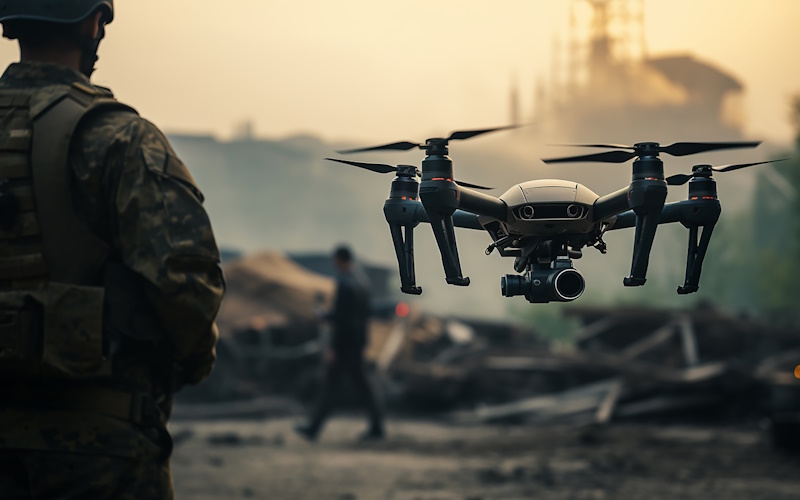Limitations of Anti-Drone Jamming: Can All Drones Be Stopped?
Drones have revolutionized industries such as surveillance, delivery, and military operations. However, they also pose significant security threats, leading to the development of anti-drone jamming systems. While these systems are effective in neutralizing unauthorized drones, they have several limitations that prevent them from being a universal solution. Understanding these limitations is crucial to developing more comprehensive drone defense strategies.
Drones have revolutionized industries such as surveillance, delivery, and military operations. However, they also pose significant security threats, leading to the development of anti-drone jamming systems. While these systems are effective in neutralizing unauthorized drones, they have several limitations that prevent them from being a universal solution. Understanding these limitations is crucial to developing more comprehensive drone defense strategies.
Ineffectiveness Against Autonomous Drones
Many drones rely on GPS or radio frequency (RF) signals for navigation and control. Anti-drone jamming systems work by disrupting these signals, rendering the drone uncontrollable. However, fully autonomous drones that operate using inertial navigation systems (INS) or pre-programmed flight paths can continue their mission without relying on external communication. This makes them resistant to traditional jamming techniques. For instance, a drone programmed with waypoints will proceed along its route even if GPS and RF signals are blocked. This limitation requires alternative countermeasures such as kinetic interception, where physical barriers or anti-drone nets are used to neutralize threats.
Limited Range of Jamming Signals
Jamming devices operate within a specific range, usually between a few hundred meters to a few kilometers. If a drone flies beyond this range, it remains unaffected by the jamming signals. Long-range and high-altitude drones, often used for military reconnaissance, can easily evade localized jamming efforts. This limitation makes it necessary to deploy multiple jamming systems across a large area to ensure effective drone mitigation. However, implementing such a wide-scale system requires significant investment and infrastructure, making it an impractical solution for many organizations.
Collateral Interference with Other Communication Systems
One major drawback of anti-drone jamming is that it does not discriminate between drones and other devices operating on the same frequency. This can lead to unintended disruptions in communication networks used by emergency services, aviation, and military operations. For example, an RF jammer deployed near an airport may interfere with aircraft navigation and control systems, posing serious safety risks. Similarly, jamming in urban areas can disrupt Wi-Fi and mobile networks, affecting the general public. To address this issue, selective and directional jamming technologies are being developed to minimize collateral damage while effectively neutralizing drone threats.
Difficulty in Detecting and Identifying Drones
Before a drone can be jammed, it must first be detected and identified as a threat. However, drones are becoming increasingly stealthy, with some designed to mimic birds or operate at low altitudes to evade radar detection. Additionally, encrypted communication signals make it difficult to determine whether a drone is operating legally or maliciously. This challenge requires the integration of multiple detection methods, such as AI-powered visual tracking, radar systems, and acoustic sensors, to improve identification accuracy. Without reliable detection, jamming efforts may be ineffective or could accidentally target harmless civilian drones.
Resistance to GPS Spoofing and RF Jamming
Advanced drones are now being equipped with anti-jamming features that make traditional countermeasures less effective. Some drones use dual-band GPS receivers that can detect spoofed signals and reject false navigation data. Others employ frequency-hopping techniques, rapidly switching communication frequencies to avoid RF jamming. Additionally, AI-driven path correction allows drones to detect interference and autonomously adjust their flight path to counteract jamming attempts. These advancements make it increasingly difficult to disable high-tech drones using conventional jamming methods, necessitating more sophisticated cyber warfare techniques and physical interception strategies.
Legal and Ethical Constraints
In many countries, the use of jamming devices is restricted due to the potential risks associated with signal interference. Governments regulate the deployment of jamming technology to prevent disruptions in essential communication networks. As a result, private individuals and organizations often lack the legal authority to use anti-drone jammers, even when facing legitimate security threats. This limitation makes it challenging for businesses, event organizers, and critical infrastructure operators to protect their airspace against unauthorized drones. A clear legal framework is required to balance security concerns with the responsible use of jamming technology.
High Cost and Maintenance
Deploying and maintaining anti-drone jamming systems requires substantial investment. High-tech counter-drone solutions, such as electromagnetic pulse (EMP) jammers and directed energy weapons (DEWs), demand significant power and infrastructure, making them cost-prohibitive for many applications. Additionally, regular maintenance is needed to ensure the effectiveness of these systems. For example, high-powered laser systems designed to disable drones require precise calibration and energy-intensive operation. Due to these high costs, only military and government agencies can afford such technologies, leaving many civilian organizations without reliable drone defense options.
Conclusion
While anti-drone jamming systems provide an essential layer of security against unauthorized drones, they are not a one-size-fits-all solution. The rise of autonomous navigation, encrypted communication, and anti-jamming technologies makes it increasingly difficult to neutralize drones using conventional jamming techniques. Furthermore, legal restrictions, high costs, and the risk of collateral interference limit the widespread use of these systems. A multi-layered approach, combining jamming with AI-driven detection, physical interception, and advanced cybersecurity measures, is necessary to address evolving drone threats effectively. As drone technology continues to advance, so too must the methods used to counteract potential security risks.
.png)






Leave a Comment
Your email address will not be published. Required fields are marked *